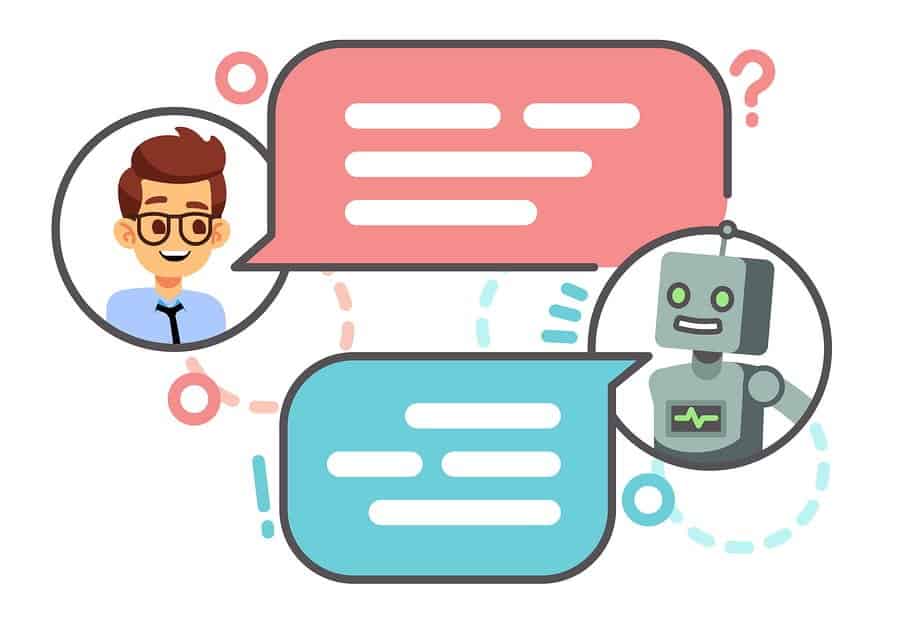Chatbots are fast-becoming the sales and marketing automation tools of the moment.
Table of Contents
ToggleWhy? Well, it comes down to the explosive growth of instant messaging services –WhatsApp, Facebook Messenger, WeChat, Viber etc. – that has taken hold over the last few years. In fact, you may be surprised to learn that messaging apps surpassed social networks in terms of global usage as long ago as 2015.

(Image source: businessinsider.com)
Naturally, as consumers have become more and more reliant on messaging apps to communicate with one another, expectations have risen for brands to enable their customers to communicate with them via these channels, too. And so, it was the initial rise of 1:1 messaging that led to the rise of chatbots in business.
But here’s the problem. When a consumer reaches out to a brand via an instant messaging service – either through a dedicated messaging app like Messenger, or a chat box pop-up on a website – that consumer indeed expects an instant reply. But of course, a business with a strong online presence may receive thousands of such messages every day – maybe even every hour – rendering it practically impossible from an affordability perspective to employ a human workforce large enough to handle all enquiries that must be answered instantly.
Chatbots are the answer. But what are they exactly, and how do they work?
What Are Chatbots?
In essence, a chatbot is a piece of robotic software capable of imitating human conversation either through text chats or voice commands (such as Siri or Alexa). Chatbots are able to provide automated, intelligent responses to questions coming from a brand’s online customers, and are used to deliver information about products and services, handle complaints, forward users to the most appropriate human representative (i.e. to handle more complex issues), and increasingly to handle direct sales.
Chatbots are now using artificial intelligence (AI) and natural language processing (NLP) to learn from and improve upon past interactions. Machine learning algorithms are deployed to improve chatbot responses – by analyzing data patterns in areas the bot has provided help with before – while NLP is used to make the bots speak more like a real human.

(Image source: chatbotsmagazine.com)
Deploying chatbots means that customers can make useful and engaging contact with brands right around the clock, while brands themselves know that their customers will have direct and instantaneous access to information as and when they need it – all while simultaneously cutting down on the man-hours required to staff and manage an instant messaging customer support service.
Chatbots are becoming increasingly popular for both B2B and B2C brands that want to create a better customer experience. In fact, Gartner predicts that 25% of customer service and support operations will integrate virtual customer assistant (VCA) or chatbot technology across engagement channels by 2020 – up from less than 2% in 2017. Gartner research also reveals that organizations report increased customer satisfaction and a reduction of up to 70% in call, chat and/or email inquiries after implementing a VCA or chatbot solution.
Speaking at the Gartner Customer Experience Summit in Tokyo in February 2018, Gene Alvarez, Managing Vice President at Gartner, said that the rise of chatbots in business comes down to how the technology has advanced in recent years. “As more customers engage on digital channels, VCAs are being implemented for handling customer requests on websites, mobile apps, consumer messaging apps and social networks,” he said. “This is underpinned by improvements in natural-language processing, machine learning and intent-matching capabilities. A great VCA offers more than just information. It should enrich the customer experience, help the customer throughout the interaction and process transactions on behalf of the customer.”
Don’t People Hate Talking to Robots?
Well, historically, yes – especially on the phone. But it’s a different game online, and as chatbot technology has improved, research reveals that many consumers are now more than comfortable with using them to communicate with the companies they do business with.
According to the State of Chatbots 2018 report, consumers believe there is much convenience to be enabled through businesses deploying chatbots – particularly for accessing quick service. And, perhaps surprisingly, it’s not just millennial consumers who see the benefits either – in fact, baby boomers are more likely than millennials to predict great benefits in five out of the ten use cases studied in the report.

(Image source: drift.com)
In addition, chatbots are proving to be a viable new channel for generating revenue. 37% of Americans say they are willing to make a purchase through a chatbot, according to DigitasLBi, and would be happy to spend more than $55 per purchase.
This trend is echoed across the pond. One in five UK consumers are willing to purchase goods and services via a chatbot, with 26-36-year-olds comfortable spending up to £481.15, and 37-47-year-olds £353.41. Great news for ecommerce merchants who ship internationally.

(Image source: blog.ubisend.com)
Chatbot Use Cases
Undoubtedly, since Facebook launched support for chatbots two years ago, adoption has been on the rise. There are now more than 300,000 bots on the platform, and the number will only continue to grow as more organizations realize the benefits. Companies like MobileMonkey are leading the way and were recently named ‘Best Marketing Bot Solution” award in the 2019 MarTech Breakthrough Awards program.
And it’s far from just an ecommerce trend. FinTechs are using the technology to provide dynamic and secure payment processing tools. Cleo, for example, is an AI-powered chatbot designed to integrate with a user’s bank accounts and credit card accounts via Facebook Messenger in order to securely analyze transaction data and provide money management tips and insights. Cleo attracted more than 350,000 users within its first four months of launch in the US, and has more than 600,000 regular users across the US, Canada and the UK.
Many different types of lawyers – from corporate to personal injury lawyers – are also utilizing chatbots on their sites. In the hotel industry, The Cosmopolitan of Las Vegas deploys Rose –a cheeky, flirty, and always-on-call chatbot concierge. Rose treats guests to VIP access to select restaurants, lets them skip lines and entrance fees at clubs, and organizes priority reservations for pool cabanas and spa treatments. Extra towels for the room? Just text Rose. Fancy a pizza at 4 a.m.? Text Rose.
When implemented with Internet of Things (IoT) technologies, chatbot technology is even being used in inventory management, enabling warehouse workers to be notified when a product is out of stock, or if a shipment has arrived at the loading dock containing out-of-stock items.
Final Thoughts
There are three main reasons behind the rise of the chatbot. The first, of course, is the popularity of messaging platforms – the medium through which many chatbots work. The second is app fatigue. Consumers are tired of installing, updating and learning how to use the mobile apps that businesses create – and businesses themselves are tired of spending heavily on mobile app development, maintenance and marketing only to find that very few people actually use them.
The third reason is that development costs have come down significantly. It’s cheaper to make a chatbot than it is to make an app these days, and there are many providers out there who make business chatbots exceptionally easy and quick to deploy – check out TARS, Botsify, Chatfuel, Flow XO and Wit.ai if you’re considering developing a bot for your organization. In addition, chatbots are cost effective for businesses – following a one-time investment plus minimal maintenance costs, they then don’t need to be paid, never get tired, and can do the work of many, many humans, saving on employment costs.
Chatbots are here to stay, and, no matter your industry, the time is now to start investigating your options (if you haven’t already), for the benefits are many, and a well-designed bot can very easily solve innumerable customer needs – in an instant.
Summary:
What Are Chatbots & Why Are They Valuable?
A chatbot is a piece of robotic software capable of imitating human conversation either through text chats or voice commands (such as Siri or Alexa). Chatbots are able to provide automated, intelligent responses to questions coming from a brand’s online customers, and are used to deliver information about products and services, handle complaints, forward users to the most appropriate human representative (i.e. to handle more complex issues), and increasingly to handle direct sales. Chatbots are now using artificial intelligence (AI) and natural language processing (NLP) to learn from and improve upon past interactions. Machine learning algorithms are deployed to improve chatbot responses – by analyzing data patterns in areas the bot has provided help with before – while NLP is used to make the bots speak more like a real human. Deploying chatbots means that customers can make useful and engaging contact with brands right around the clock, while brands themselves know that their customers will have direct and instantaneous access to information as and when they need it – all while simultaneously cutting down on the man-hours required to staff and manage an instant messaging customer support service.






